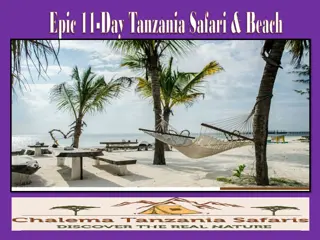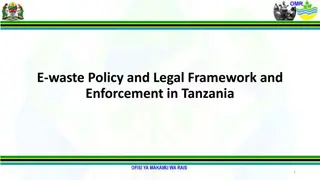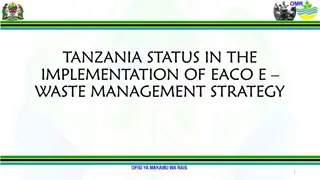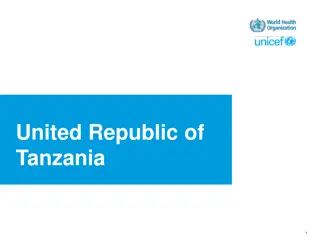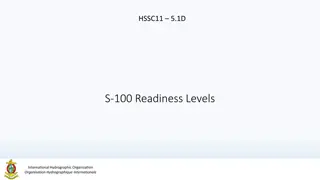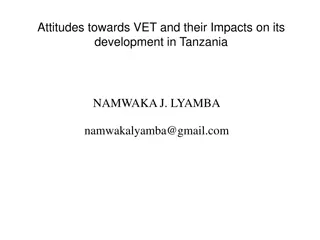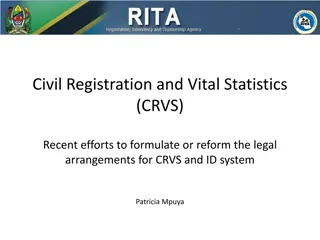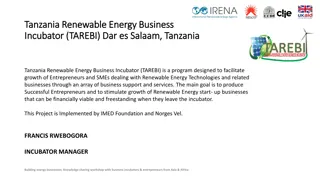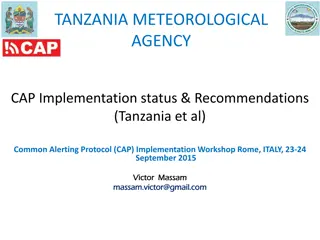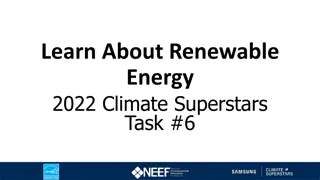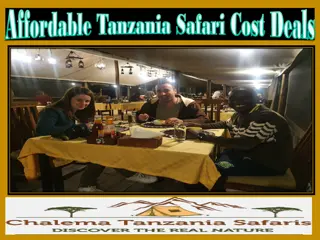
Renewables Readiness Assessment in Tanzania: Energy Structure and Challenges
This report presents an analysis of Tanzania's energy landscape focusing on the renewables readiness assessment. It delves into the current energy structure in Tanzania, highlighting the primary sources and consumption patterns in 2012. The electricity generation and consumption by sector, along with cost and tariff implications, are examined in detail. The document also addresses the electricity supply industry reform strategy and roadmap for achieving additional capacity by 2025. Furthermore, it discusses the urgent need for a transition to cheaper electricity and the potential impacts on the Tanzanian economy.
Download Presentation

Please find below an Image/Link to download the presentation.
The content on the website is provided AS IS for your information and personal use only. It may not be sold, licensed, or shared on other websites without obtaining consent from the author. If you encounter any issues during the download, it is possible that the publisher has removed the file from their server.
You are allowed to download the files provided on this website for personal or commercial use, subject to the condition that they are used lawfully. All files are the property of their respective owners.
The content on the website is provided AS IS for your information and personal use only. It may not be sold, licensed, or shared on other websites without obtaining consent from the author.
E N D
Presentation Transcript
Renewables Readiness Assessment Renewables Readiness Assessment - -Background Background Jensen Jensen Shuma IRENA IRENA - - local consultant local consultant Dar Dar es es Salaam, 9 March 2016 Salaam, 9 March 2016 Shuma
Energy Structure in Tanzania in 2012 Total Primary Energy Supply Final Energy Consumption by sector Other 4% Oil products 10% Industry 14% Natural gas 4% Hydro 1% Agriculture 4% Transport 8% Residential 70% Primary solid biofuels 85% 2
Electricity generation by source in 2012 Electricty output in 2012 (GWh) 3,500 Natural gas, 2,940 3,000 2,500 2,000 Hydro, 1,657 1,500 Oil products, 1,166 1,000 500 Primary solid biofuels, 19 Solar PV, 13 0 Oil products Natural gas Hydro Primary solid biofuels Solar PV 3
Electricity consumption by sector in 2012 Other 4% Commercial and public service 23% Industry 25% Agriculture 4% Residential 44% 4
Electricity peak demand and consumption forecast 5
Electricity Costs and Tariffs The power shortage emergency (2010/11) has pushed Tanzania into a major expansion The power shortage emergency (2010/11) has pushed Tanzania into a major expansion of thermal generation at great of thermal generation at great costs. costs. Songas Songas electricity costs $ electricity costs $0.066/kWh 0.066/kWh Emergency Emergency thermal units (Jet A1 and Diesel) cost ranges from $0.30/kWh to $0.43/kWh thermal units (Jet A1 and Diesel) cost ranges from $0.30/kWh to $0.43/kWh Average Average household tariffs $0.13/kWh, household tariffs $0.13/kWh, industrial industrial tariffs: $0.056/kWh, tariffs: $0.056/kWh, commercial commercial tariffs: $0.105/kWh tariffs: $0.105/kWh Therefore, in the medium Therefore, in the medium- -to the long to the long- -term, a transition to cheaper electricity is vital for term, a transition to cheaper electricity is vital for both the Tanzanian economy and for efforts to expand energy access in the country. both the Tanzanian economy and for efforts to expand energy access in the country. Rising average costs will make maintenance of current tariff levels difficult without Rising average costs will make maintenance of current tariff levels difficult without driving TANESCO into insolvency driving TANESCO into insolvency. . 6
Electricity Supply Industry Reform Strategy and Roadmap Source Current Capacity (MW) (March, 2013) 565.8* 456.3 501 27 0 0 0 0 14 1564.1 Additional Capacity (MW) Total Capacity by 2025 (MW) Hydro Oil Natural gas Biomass Coal Wind Solar Geothermal Interconnection Total 1,529 0 3,968 0 2,900 200 100 200 400 9297 2,095 456 4,469 27 2,900 200 100 200 414 10,861 7
Renewable Energy Resources Abundant resources of hydropower, wind, solar, biomass and geothermal power. Large hydro: estimated at 4,700MW, only 561MW is developed, by 2025, expected to meet 30% of the installed capacity Small hydro: 480 MW, only 15 MW to the grid and over 20 MW for decentralized power generation Geothermal: 650 MW to 5,000 MW Wind: no estimate of the potential just speed is known at 10- 30 m hub-height Solar: no estimate of the potential only the isolation (5 kWh/m2/day) is known Biomass: no estimate of the potential, only the consumption of woody biomass is known 8
Energy Policies and Regulatory Framework The Tanzania Development Vision 2025 is still the main strategy document in outlining the general development for Tanzania. The vision has been made more concrete in the Tanzania Long-Term Perspective Plan (LTPP) 2011/12-2025/26, published in June 2012 outlines a roadmap towards a middle- income country. The Tanzania Five Year Development Plan 2011/2012- 2015/16 shows what has to be done in the shorter perspective in order to implement Vision 2025. Finally, the MEM has published their strategic plans for 2011/12-2015/16 in November 2012. These documents set energy as a national priority and point to investing in the sector as a means to maintain economic growth and spread out its benefits to the overall population. The National Energy Policy (NEP) in 1992, which was subsequently revised in 2003 and latest version is 2015. 9
Energy Policies and Regulatory Framework Some of the achievements registered during implementation of this policy include: the enactment of the Electricity Act (2008), the Petroleum Act (2008), the Rural Energy Act, 2005; the establishment of Standardised Power Purchase Agreement and Tariffs (2008); establishment of the Rural Energy Agency and Rural Energy Fund (2007); the establishment of Energy and Water Utilities Regulatory Authority - EWURA (2006). The latest NEP 2015, includes more aggressive approaches for easier entry for private sector participation and alternative energy technologies The Renewable Energy sector Tanzania is guided by a number of polices and legislations including amongst others: Electricity supply industry reform strategy and roadmap (2014), Climate Change Adaption Plan and strategy (2016), Feed-in Tariff Policy, Rural Energy Strategy and Master Plan, Electricity supply industry reform strategy and roadmap. 10
Financing and Investment Tanzania recorded the highest total Foreign Direct Investments (FDI) in 2013 (USD 1.872 billion) out of USD 6.2 billion invested within the East African Community. From 1997 and 2014, Tanzania hosted 12 FDI projects in the energy sector (11 for power and 1 for gas) for a total of USD 960 million (of which USD 644 million were for electricity) The foreign investments have interested exclusively independent producers and EPPs in thermal generation activities (mainly through natural gas). New FDI in the RE sector is foreseen in the SREP and the PSMP, which could be of interest to the wind, biomass, solar and geothermal sub-sectors. On-going donor and government supported Projects for developing transmission and distribution grids as well as the increase of access to electricity (both grid connected and decentralized) Investment code provides incentives to projects developers Low involvement of local private operators in the energy sector mainly in the power development 11
Human Capacities Various universities and research and training institutions focus on building human capacity for the energy sector. These include the University of Dar es Salaam, Dar es Salaam Institute of Technology, Mbeya Institute of Science and Technology, Arusha Technical College and the Vocational Education Training Authority (VETA). Although research is stipulated in the energy policy, the country does not have specific institution for energy research. Researches in the form of studies are conducted through consultancies by different stakeholders such as CAMCO, ESRF, REPOA, TaTEDO, IRA, COSTECH, SUA, GST, etc. Research and Development efforts that give rise to technological innovations in the energy sector are important as drivers for energy sector development and its growth. 12
Identified Challenges Unknown resource potential for Variable Renewable Energy Target for RE in the Master Plan is low Heavy reliance on hydro and fossil fuels for power generation in medium term Costs of Renewable Energy generation are competitive with high emergency thermal units Low involvement of local private operators in the energy sector mainly in the power development Limited local financing and technical (RE project development and implementation) capacities. 13


